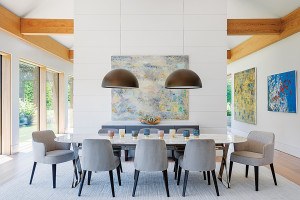10 Questions with Interior Designer Meichi Peng

A look at a dining area designed by Meichi Peng.
With clean lines and eclectic accents, Meichi Peng helps her clients express their individuality and feel serene. Peng, the founder of Peng Furnishings, lets us in on how to create a soothing, aesthetic space and why going the distance for your dream is always worth it.
1. How did you decide that a design career was the right path for you?
It was by coincidence. When I was a teenager, I actually wanted to be a fashion designer. I grew up in Taiwan, and my parents were are all business. They said, “You’re not going to survive as a fashion designer.” It wasn’t treated as a real profession. Out of coincidence, when pursuing fashion design, I ended up taking on interior design. And I knew that one day I would be able to use this skill set.
2. What has been your greatest inspiration throughout your career?
I like to travel. I travel quite often. And I think, through the travel, you get a chance to meet people, a chance to see surroundings and choice of lifestyle. That is translated into my interior design.
3. What can shoppers expect when they walk into your South End store, Peng Furnishings?
The shop here is very eclectic. I also have a line of handbags called Peng Bags, so the shop here is actually a combination of both displays. One-third of the showroom you see the handbags, and the other two-thirds of the showroom are the furnishings that we’ve brought in from around the world. Most of them are one-of-a-kind, unique, sculptural antique pieces.
4. How can clients expect to feel when they see a space you’ve created for them?
We do a lot of contemporary, very clean designs. But we also want that contemporary, clean design to be very comfortable — the comfort level is actually one of our key concerns. So we don’t really have a set style, we listen to what the client is looking for. At the end of the day, when we complete a project, it’s their home. It needs to reflect who they are, and really address their personality and their lifestyle because it’s custom-tailored. We add our creativity and translation of what they want to the space. The most rewarding thing is when a client says to us, “Oh my gosh, this is exactly what we like! We really enjoy it, and we love the space, and it functions how we want to live.” That’s usually the what’s most rewarding after the long process — to hear the client say that they really enjoy and love the space. It’s really about them, reflecting who they are and their lifestyle.
5. When did you realize your identity as an artist and cultivate your style?
I used to work for a big architectural firm. We would do a lot of big-scale projects. The artist inside of me always liked to do that artistic stuff, and I continued using that creativity for the interior. Right after I started my business, it allowed me to express a lot more personal identity for the individual, residential customer. When I was working for the architectural firm it was more big-scale projects for the developer — more about what makes it sell versus [a project] custom-tailored for the individual. I think that’s where the style and skill develop.
6. How do you achieve such clean, eclectic look and still make it feel harmonious?
Keep it clean, and keep it simple. It’s about the balance. If you want a clean look, you select a few very key pieces that play along with the design. Don’t do too much. Usually people make the mistake of trying to crowd in a bunch of pieces and get too much in there. And it kills the look. It kills the line and the cleanness of the space.
I do believe that design is really meant to go with flow — you don’t want it to be too contrived. Less is always better. Keep it simple because sometimes people try to do so much and then have too many ideas rolled into one. And the space becomes too busy. Have one idea and stick to that one idea all the way through, versus having five ideas and trying to put it all into one space.
7. What should people avoid when attempting a clean, relaxing atmosphere?
A lot of times we will get a call for a project and the client had been trying to do it on their own. The most classic case was when [a client] went shopping at a design center or [[OR? FOR? AT?]] an Italian furniture store. They saw lots of pieces, they fell in love with them, and they tried to place them in their house. Then they called us and said, “I already spent $20,000 on this sofa you have to work around it.”
A lot of times people make a mistake and just went out shopping without master-planning. A good design starts with a good layout. And that’s really a key ingredient. A lot of times people buy pieces without knowing what the furnishing layout should look like. In my philosophy of design, you have to do a design layout of the space, design a furnishing layout and fit it to your lifestyle. You go shopping based on your furniture layout. You have to plan it out.
8. You use a lot of museum-like pieces and ancient artifacts. What inspired the use of those elements?
At the end of a project we help the client sourcing accessories that are one-of-a-kind to display, to complete the whole look of the interior. There was always a very limited source for what you could find here. You end up buying stuff that is mass-produced, from a major retail space, that doesn’t really posses a personality. A more unique item showcases the client and showcases a project in a much more interesting way. So it gave me this idea that, through travel—whether shopping in Italy or a vintage store—I could acquire items to complete Peng Furnishings. Anyone can come in here looking for a unique item to furnish their space.
9. When did Boston become your home?
I came here in 1993. I was 18 years old. I was studying chemical engineering in Taiwan, and I realized it wasn’t for me. I told my parents I would like to study abroad. At that time, I didn’t know anybody here. I applied for school [ at Wentworth Institute of Technology], and I came by myself. And I remember the night I came here there was snow. I came from a country where it doesn’t snow, so I thought oh my gosh, this is a big difference. My whole family is still back in Taiwan. When I finished college I wanted to get experience and work for a little bit. I was thinking about going to architectural school, and then perhaps going back home. Life usually takes you a very different way. After I finished school, I got a job over at a big architectural firm in downtown Boston. I worked there for about eight years. Then I decided to start my business. My parents thought there was a chance I’d be coming home, but now they gave up. I do go back every year for two weeks for Chinese New Year. That was my promise to them.
10. You do commercial and residential projects. How do you approach each? Is one more challenging or enjoyable than the other?
I think both are challenging in many different ways. Working on the commercial projects, they have a very different budget, and the design is designed to sell. When working for a developer, their primary goal is using the design to sell the space or the lifestyle. Everything has to be very long-lasting, super durable. It not only has to look good for the first day, it has to look good five years on because so many people use it. You design for the public. The residential side is different. The residential side, depending on the client, is more about the comfort, the luxury, the texture, the feel. And it’s really about the self-identity, about who they are. So, when we get hired to design in their home, it really is all about them. You listen to how they live, what they want and create a home for them.
Check out more by Meichi Peng below:




